Understanding Fly Fishing Boots: Features and Benefits
Choosing the right gear is crucial for any angler, and Fly fishing boots play a significant role in ensuring a successful outing on the water. These specialized boots provide key features that enhance performance, comfort, and safety while wading through rivers, lakes, or saltwater environments. This guide delves into the essential characteristics of high-quality fly fishing boots, detailing their benefits and considerations to find the best fit for your fishing adventures.
Key Features of High-Quality Fly Fishing Boots
High-quality fly fishing boots incorporate several key features designed to optimize performance and comfort. When selecting boots, look for the following attributes:
- Waterproofing: Effective waterproof materials keep your feet dry while wading through wet conditions. Look for boots made from materials such as Gore-Tex or other breathable membranes that allow moisture to escape while keeping water out.
- Traction: Soles designed with rubber or felt provide maximum grip on slippery surfaces. Rubber soles excel on wet rocks, while felt soles are excellent for maintaining traction in slippery freshwater conditions.
- Support and Stability: High ankle support is integral for providing stability during movement over uneven terrains. This feature also reduces the risk of ankle injuries.
- Comfortable Fit: A proper fit is essential for comfort. Look for boots that have adjustable features like laces, straps, or BOA systems that help secure the fit according to your preferences.
- Drainage: Boots with internal drainage systems allow water to exit quickly. This not only enhances comfort but also prevents the buildup of weight from absorbed water.
Material Types and Their Performance
Various materials are used in the construction of fly fishing boots, with each offering unique advantages. Understanding these materials will help you select boots that best meet your needs:
- Neoprene: Ideal for colder conditions, neoprene boots provide insulation and are often used in wet wading environments. However, they can be less breathable, which may cause discomfort in warmer weather.
- Synthetic Fabrics: Lightweight and quick-drying materials are often used in modern boots. These fabrics enhance breathability and keep feet comfortable in varying conditions.
- Leather: Traditional leather provides durability and resistance to wear and tear. While they offer excellent protection, leather boots may take longer to dry and require more maintenance.
Importance of Fit and Comfort
Fit and comfort are non-negotiable when it comes to fly fishing boots. An ill-fitting pair can lead to blisters, cold feet, and distraction while you’re trying to focus on your fishing experience. To ensure a proper fit:
- Try on boots with the socks you intend to wear while fishing.
- Consider the shape of your feet; different brands may cater to various widths and arch types.
- Ensure there is enough room in the toe box while having a snug fit around the ankles to prevent unwanted movement.
Types of Fly Fishing Boots for Different Environments
Choosing the right type of fly fishing boots depends largely on the water conditions and environments you plan to fish. Below we explore the various types available:
Freshwater vs. Saltwater Boots
When it comes to wading through freshwater streams versus saltwater environments, the design of your boots can make a significant difference:
- Freshwater Boots: Typically equipped with felt soles, freshwater boots excel in providing traction on slippery rocks. Their construction often prioritizes quick-drying materials to ensure they are less prone to water retention.
- Saltwater Boots: These boots tend to have rubber soles to withstand the corrosive nature of saltwater. They also usually come equipped with drainage ports to release water quickly and feature higher durability standards to resist salt damage.
Choosing Between Wading Boots and Non-Wading Options
Wading boots are specifically designed for anglers who spend time in the water, while non-wading boots may suffice for bank fishing or walking along shorelines. Here’s what to consider:
- Wading Boots: Built for optimal comfort and stability while entering water, these boots often feature supportive soles and ankle support. They’re also designed to drain quickly.
- Non-Wading Boots: Primarily designed for hiking to and from fishing spots, these might not provide sufficient traction or waterproofing for serious wading conditions.
Specialized Boots for Specific Conditions
Certain fishing environments can call for specialized boots tailored to specific challenges:
- Boots for Rocky Terrain: Look for boots with sturdier ankle support and rubber soles for enhanced traction.
- Boots for Sandy Beaches: Lightweight and quick-drying options with ample drainage capabilities are ideal. Consider models that minimize sand retention.
Essential Buying Guide for Fly Fishing Boots
With countless options available, selecting the perfect pair of fly fishing boots can be challenging. Here’s a detailed buying guide to make the process easier:
What to Look for When Shopping for Fly Fishing Boots
When shopping for fly fishing boots, consider the following:
- Type of Fishing: Are you wading in freshwater or sliding through saltwater? Your fishing style will dictate the ideal boot type.
- Comfort: Always prioritize comfort and fit; look for features like cushioned insoles and adjustable fasteners.
- Price vs. Quality: Decide your budget but weigh it against the durability and quality of the materials. High-quality boots can be more cost-effective in the long run.
Price Ranges Compared: Budget to Premium Options
Fly fishing boots can range significantly in price:
- Budget Range: Prices can start as low as $50, providing basic functionality for occasional anglers.
- Mid-Range: Expect to pay between $100 to $200 for durable, reliable options that offer additional features.
- Premium Range: Expect boots costing $200 and above to include advanced technology, better materials, and a longer lifespan.
How to Make an Informed Choice
Making an informed choice involves research and consideration:
- Read reviews from fellow anglers about the performance and durability of the boots you’re considering.
- Consult with local fishing shops or online forums for specific recommendations based on your water conditions.
- Try different models on in-store, if possible, to ensure you find the best personal fit.
Care and Maintenance of Fly Fishing Boots
Proper care and maintenance extend the life of your fly fishing boots and maintain their performance. Here are some essential practices:
Cleaning Techniques for Longevity
After each fishing trip, it’s crucial to clean your boots to prevent dirt and grime buildup:
- Rinse off any mud, sand, or debris with fresh water. Use a soft brush to clean off stubborn particles.
- Let them air dry completely, avoiding direct heat sources that may damage the materials.
- Apply conditioners for leather boots as necessary to maintain flexibility and prevent cracking.
Storing Your Boots to Prevent Damage
How you store your boots can impact their longevity:
- Store in a dry, cool place away from direct sunlight to prevent material degradation.
- Use boot trees or stuff them with newspaper to maintain their shape during storage.
Repairing Common Wear and Tear
As with any footwear, wear and tear can occur. Know the basic repairs to maintain your boots:
- Replace worn-out soles if possible. Some models may allow for sole replacement, which can extend the boots’ life significantly.
- Patch small leaks or cuts with waterproof sealants to prevent further damage.
Trends in Fly Fishing Boots: What’s New in 2025
As the fishing gear industry evolves, several emerging trends are influencing the design and functionality of fly fishing boots:
Advancements in Technology and Design
Modern materials and technology are making fly fishing boots more efficient:
- Innovative sole designs that enhance flexibility and grip are becoming more common, addressing the need for both comfort and stability.
- Integrated drainage systems allow for quicker water expulsion, resulting in a lighter boot during prolonged water exposure.
Eco-friendly Materials and Sustainability
Growing environmental concerns encourage manufacturers to adopt sustainable practices, leading to:
- The use of recycled materials in boot construction that maintain durability while lessening ecological impact.
- Designs emphasizing longevity and recyclability, ensuring boots are crafted for long-term use rather than fast fashion.
Community Insights on the Latest Offerings
Community forums and angler reviews are key in identifying trending boots and improvements:
- Engagement with online communities helps reveal user preferences and feedback on recent boot releases.
- Participation in local fishing clubs can provide firsthand experience from fellow anglers on the latest innovations in gear.






Leave a Reply